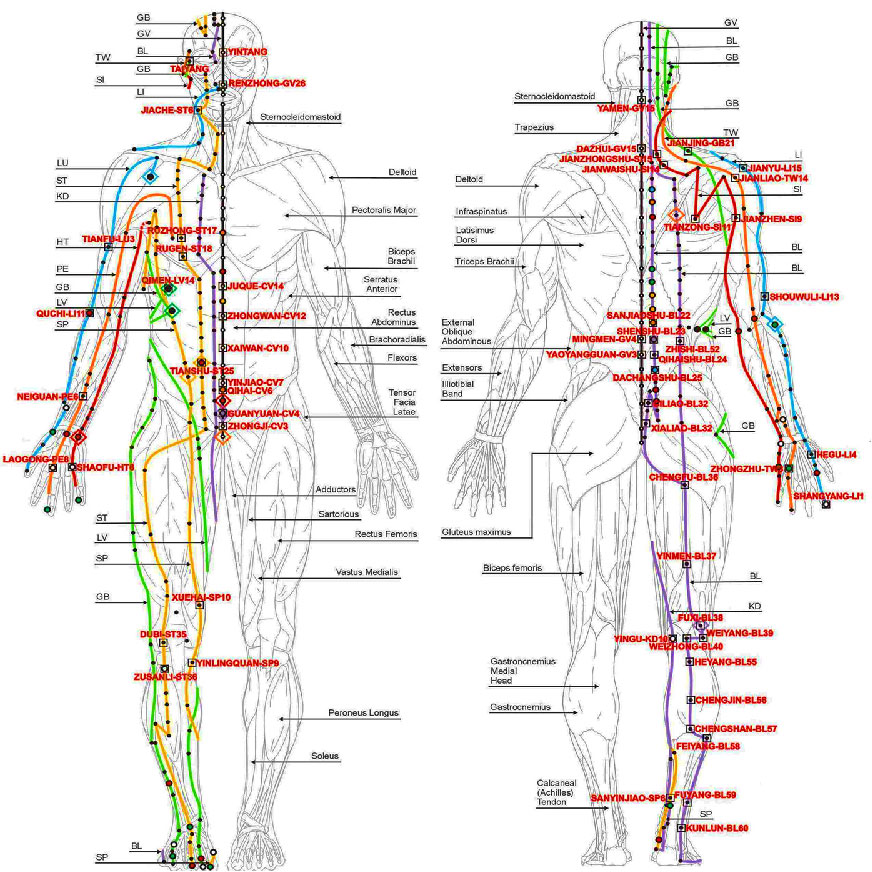

Shaoyin Heart Channel of Hand ( 手少阴心经) or Hand's Minor Yin Heart Meridian Taiyin Lung Channel of Hand ( 手太阴肺经) or Hand's Major Yin Lung Meridian The table below gives a more systematic list of the 12 standard meridians: Meridian name (Chinese) The Yang meridians of the leg are Stomach, Bladder, and Gall Bladder. The Yin Meridians of the leg are the Spleen, Kidney, and Liver. The Yang meridians of the arm are the Large Intestine, Small Intestine, and Triple Burner. The Yin meridians of the arm are the Lung, Heart, and Pericardium. The 12 standard meridians, also called Principal Meridians, are divided into Yin and Yang groups. There are also "Eight Extraordinary Channels", two of which have their own sets of points, and the remaining ones connecting points on other channels. There are "12 Principal Meridians" where each meridian corresponds to either a hollow or solid organ interacting with it and extending along a particular extremity (i.e. However, by the second Century AD, 649 acupuncture points were recognized in China (reckoned by counting bilateral points twice). 12 primary and eight extraordinary channels). There are about 400 acupuncture points (not counting bilateral points twice) most of which are situated along the major 20 pathways (i.e.

Note that this method ignores the fact that the bulk of acupoints are bilateral, making the actual total 670. If one counts the number of unique points on each meridian, the total comes to 361, which matches the number of days in a year, in the moon calendar system. The collateral system also incorporates a branching expanse of capillary-like vessels which spread throughout the body, namely in the 12 cutaneous regions as well as emanating from each point on the principal meridians. The collaterals contain 15 major arteries that connect the 12 principal meridians in various ways, in addition to the interaction with their associated internal organs and other related internal structures. The jingmai contain the 12 tendinomuscular meridians, the 12 divergent meridians, the 12 principal meridians, the eight extraordinary vessels as well as the Huato channel, a set of bilateral points on the lower back whose discovery is attributed to the ancient physician Hua Tuo. The meridian network is typically divided into two categories, the jingmai ( 經脈) or meridian channels and the luomai ( 絡脈) or associated vessels (sometimes called "collaterals"). In the texts, the meridians are referenced as mài ( 脈) rather than jīngmài. The concept of meridians are first attested in two works recovered from the Mawangdui and Zhangjiashan tombs of the Han-era Changsha Kingdom, the Cauterization Canon of the Eleven Foot and Arm Channels ( 足 臂 十一 脈 灸 經, Zúbì Shíyī Mài Jiǔjīng) and the Cauterization Canon of the Eleven Yin and Yang Channels ( 陰 陽 十一 脈 灸 經, Yīnyáng Shíyī Mài Jiǔjīng). ( October 2020) ( Learn how and when to remove this template message) Unsourced material may be challenged and removed. Please help improve this article by adding citations to reliable sources in this section. This section needs additional citations for verification.


 0 kommentar(er)
0 kommentar(er)
